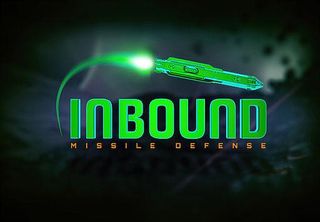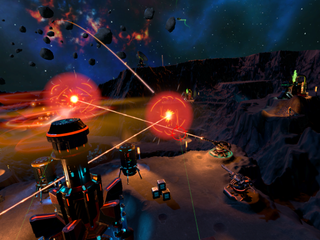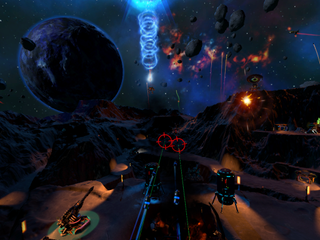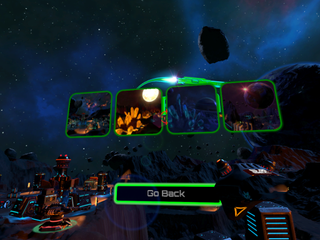Exclusive First Look: Getting Obliterated By 'Inbound' Rockets

A little over a month ago, we had the chance to speak with the founders of Gyoza Games about their upcoming Vive game, Inbound. Gyoza is approaching the launch of the game and invited us to give it an early look.
Colony structure critical! Colony structure destroyed! Those were the words being repeated in my ear during my first few moments with Gyoza Games’ first title, Inbound. Being bombarded with incoming missiles and bombs can quickly feel overwhelming. Fortunately, it didn’t take long to grasp the controls. By my second round, I was in much better shape to take on the barrage of incoming incendiaries that threatened my mining facility.

Inbound is a modern spin on the classic missile defense arcade genre. You play as the defense commander in charge of protecting an asteroid-based mining colony from a variety of incoming enemy attacks. You have a god-like perspective over the world you are tasked to protect, almost like playing with miniatures or a diorama display. You control the colony’s defense turrets by pointing two crosshairs at incoming attacks and firing at will.
Attacks From Everywhere
The turrets are used to defend against the incoming missiles and bombs that are fired from over the horizon. There are multiple types of airborne attacks, and you will have to adjust your timing for each one. The missiles come in quickly, but I found it easy to time my shots and predict where the attack was heading. You have to aim your shots in front of the incoming missiles, not directly at them. There are also slower airborne attacks that you have to watch out for. Fortunately, your turret fire explodes with a large blast radius, so you don’t have to have perfect aim.
You won’t just be dealing with incoming long range attacks. You’ll also have to take out bomber planes that fly overhead and drop smaller bombs. These planes will swoop in without notice, and they can be hard to shoot out of the sky.They often fly higher than your turret fire’s range.

Inbound also features ground-based attacks from mechs and tankbots that drop onto the map from time to time. These enemies are never within the range of the turret fire, so you have to use grenades to take them out. To toss grenades, you must press on the Vive controllers trackpad. Unlike turret fire, which is ground-based, grenades are thrown from your hands. The grenades appear to be unlimited, which is helpful because spamming mechs with as many as you can at once seemed to be the most effective method for taking them out quickly.
If you get far enough into the game, you’ll face an additional flying enemy that stays out of range of the turrets. It resembles a cluster of three flying saucers and fires laser beams at your buildings. You have to take these out with grenades, but they usually show up when you’re already busy with plenty of other incoming fire.
Stay on the Cutting Edge
Join the experts who read Tom's Hardware for the inside track on enthusiast PC tech news — and have for over 25 years. We'll send breaking news and in-depth reviews of CPUs, GPUs, AI, maker hardware and more straight to your inbox.
Disturb The Fabric Of Time
Gyoza Games does give you a tool to help you get you through the really intense moments. When things get a little bit out of hand and there’s too much on the screen at once, squeeze the grip buttons to activate Time Distortion. This function slows down time briefly to help you get past the most intense moments. Time Distortion is available only for a limited amount of time. There’s a readout on one of your controllers that displays how much time distortion you have left. You start with five seconds per hand, but it is possible to gain more time.

Occasionally, while you are fighting and in between waves, you’ll see a power-up box drop from the sky above your colony. If you manage to shoot the box with your turret, you’ll either get repairs for your structures or extra time distortion. The supply drops seem to be few and far between, so you’ll want to pay attention for those.

The enemy attacks come in waves that get progressively harder. Your score is tabulated after each wave using a number of factors. You get points for taking out enemy fire before it hits your colony and for destroying enemy airships and ground units. Your score is also multiplied by the number of buildings and weapons that are still intact after each wave.
Inbound features four different maps to choose from. They all offer the same mechanics, but the different topology changes how each map is played out.

The first map, Driftstone, appears to be inside a crater. In the distance, you see a wall of rock. The mining colony is inside the crater. Ground enemies come over the cliff, and airborne attacks originate from behind the cliffs. The second map, Devil’s Spit, is situated inside a volcano. There’s glowing orange lava that flows through the rock around you, which lights up the environment. This map feels much more enclosed, though, because you’re surrounded by cliffs in every direction.
The third map is called Junction Rock. This environment is much more open than the first two. There are far fewer cliffs and rocks to use as shelter. You also start with three turrets in Junction Rock instead of four, as in the first two maps. This map feels much darker than the first two, and it seemed like there were more incoming airborne attacks.The fourth and final map is called Suitors Landing. It has the most wide open terrain of all of the maps, which leaves your structures somewhat vulnerable.
Available Soon
Inbound will eventually be available on Oculus Rift and PSVR, as well as 2D screens, but the initial release of the game is designed specifically for the HTC Vive. Gyoza Games will be launching Inbound on Steam on June 30. The price is not set in stone yet, but Gyoza said that it plans to sell the game for $15.
Follow Kevin Carbotte @pumcypuhoy. Follow us on Facebook, Google+, RSS, Twitter and YouTube.
Kevin Carbotte is a contributing writer for Tom's Hardware who primarily covers VR and AR hardware. He has been writing for us for more than four years.
Most Popular



